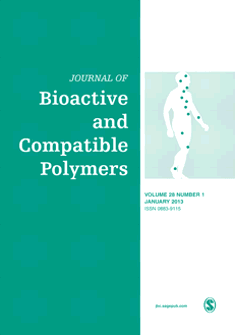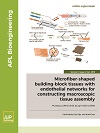
Biomaterials Research
Scope & Guideline
Leading the charge in materials innovation.
Introduction
Aims and Scopes
- Tissue Engineering and Regenerative Medicine:
Research in this area focuses on developing biomaterials that can support tissue regeneration and repair. The journal publishes studies involving scaffolds, hydrogels, and other materials designed to mimic the extracellular matrix and promote cell proliferation and differentiation. - Nanotechnology in Medicine:
The journal highlights advancements in nanomaterials and their applications in drug delivery, imaging, and therapy. This includes the development of nanoparticle-based systems that enhance therapeutic efficacy while minimizing side effects. - Biocompatibility and Biointegration:
Research on the interaction between biomaterials and biological systems is a core focus. The journal publishes studies that evaluate the biocompatibility of materials and their ability to integrate with host tissues, essential for successful implantations. - Smart Biomaterials:
The journal emphasizes the development of smart biomaterials that respond to environmental stimuli. These materials can change their properties in response to factors like pH, temperature, or light, making them suitable for targeted drug delivery and controlled release applications. - Immunomodulation and Cancer Therapy:
Research exploring the use of biomaterials to modulate immune responses and their applications in cancer therapy is increasingly featured. This includes the development of biomaterials that enhance the efficacy of immunotherapies.
Trending and Emerging
- 3D Bioprinting and Biofabrication:
An increasing number of studies are focusing on 3D bioprinting techniques to create complex tissue structures. This trend reflects the need for advanced manufacturing processes in tissue engineering. - Immunotherapy and Biomaterials:
There is a growing emphasis on the role of biomaterials in enhancing immunotherapy approaches, particularly in cancer treatment. These studies explore how biomaterials can modulate the immune response to improve treatment outcomes. - Personalized Medicine:
Research is increasingly directed towards developing biomaterials tailored to individual patient needs, utilizing patient-specific cells and materials to enhance therapeutic efficacy and safety. - Extracellular Vesicles and Biomaterials:
The application of extracellular vesicles in drug delivery and regenerative medicine is gaining traction. This emerging theme explores how these biological carriers can be integrated into biomaterial systems for enhanced therapeutic effects. - Microenvironment Engineering:
Recent publications highlight the importance of engineering the cellular microenvironment within biomaterial scaffolds. This includes studies on how to manipulate biochemical and mechanical signals to promote desired cellular behaviors.
Declining or Waning
- Traditional Biomaterials without Functionalization:
There has been a noticeable decline in research focused on traditional biomaterials that do not incorporate advanced functionalization techniques. The trend is moving towards more complex materials that enhance biological interactions. - Non-biomimetic Scaffolds:
The focus on purely synthetic scaffolds that do not mimic natural extracellular matrix properties is waning. There is a growing preference for biomimetic designs that promote better integration and functionality in vivo. - Basic Mechanical Properties Studies:
Research that solely investigates the mechanical properties of biomaterials without correlating to biological outcomes is decreasing. The field is increasingly prioritizing studies that link mechanical performance with biological responses. - Single-use Biomaterials:
Research on single-use biomaterials is less frequently published. There is a shift towards developing sustainable, reusable materials that contribute to environmental conservation and cost-effectiveness.
Similar Journals

Regenerative Biomaterials
Exploring New Frontiers in Regenerative MedicineRegenerative Biomaterials, published by Oxford University Press, serves as a premier platform for the dissemination of innovative research in the rapidly evolving field of biomaterials. Since its inception in 2014, this esteemed open-access journal has fostered a collaborative and diverse scientific community, providing free access to impactful articles that enhance our understanding of regenerative medicine and tissue engineering. With a commendable impact factor and ranking within the top quartiles of both Biomedical Engineering and Materials Science, it is recognized for its rigorous peer-review process and high-quality publications. The journal aims to bridge the gap between fundamental research and applied sciences, promoting advanced studies that contribute to clinical applications and regeneration strategies. Researchers, practitioners, and students alike are encouraged to engage with the journal’s content to foster interdisciplinary collaboration and drive future innovations in the biomaterials domain.

International Journal of Biomaterials
Fostering collaboration for breakthrough advancements in biomaterials.The International Journal of Biomaterials, published by HINDAWI LTD, is a premier platform for disseminating groundbreaking research in the fields of biomaterials and biomedical engineering. With an Open Access approach since 2009, this journal provides unhindered access to innovative studies and applications aimed at advancing medical technologies and improving patient outcomes. Notably ranked in the Q3 category for both Biomaterials and Biomedical Engineering in 2023, it serves as an essential resource for researchers, practitioners, and students alike. The journal's Scopus rankings, including a 49th percentile in Biomedical Engineering and a 40th percentile in Biomaterials, further underscore its growing prominence in the academic community. With contributions spanning from 2011 to 2024, the journal seeks to foster collaborative research and promote developments that enhance the understanding and application of biomaterials in healthcare.

Biomedical Materials
Transforming Science into Life-Saving Solutions.Biomedical Materials, published by IOP Publishing Ltd, is a premier journal dedicated to the rapidly evolving field of biomedical engineering and materials science. With a robust impact factor showcasing its influence, this journal serves as a vital platform for disseminating pioneering research from 2006 to 2024. Covering an array of interdisciplinary topics—ranging from biomaterials to bioengineering and applied chemistry—the journal consistently ranks in the second quartile across multiple categories including Bioengineering (Q2), Biomaterials (Q2), and Biomedical Engineering (Q2) as of 2023. Researchers, professionals, and students alike benefit from its contributions, exploring innovative solutions at the intersection of biology and material science. Although not an Open Access journal, Biomedical Materials remains essential in advancing our understanding and facilitating discussions surrounding state-of-the-art materials that revolutionize medical applications and enhance patient care.

ACS Biomaterials Science & Engineering
Advancing the Future of Biomaterials and Biomedical EngineeringACS Biomaterials Science & Engineering, published by the American Chemical Society, serves as a premier platform for the latest advancements and research in the fields of biomaterials and biomedical engineering. With an impressive impact factor and a strong reputation reflected in its ranking—Q2 in Biomaterials and Q1 in Biomedical Engineering—the journal attracts a diverse and engaged readership. Since its inception in 2015, it has aimed to foster innovation by publishing high-quality research articles, reviews, and perspectives on the synthesis, characterization, and application of biomaterials. Researchers and professionals benefit from the journal's rigorous peer-review process and its focus on translational science, making it essential for those looking to stay at the forefront of biomaterials research. Located in Washington, DC, USA, the journal plays a pivotal role in connecting academic and industrial sectors, ultimately driving advancements that impact biomedicine and related fields.

COLLOIDS AND SURFACES B-BIOINTERFACES
Advancing Knowledge at the Intersection of Biology and ChemistryCOLLOIDS AND SURFACES B-BIOINTERFACES is a premier interdisciplinary journal published by Elsevier, dedicated to advancing the knowledge of interfaces and interactions in biological systems and their applications in biotechnology. With an impressive impact factor that underscores its significance in the field, the journal ranks in the Q1 category for Biotechnology, Medicine, and Physical and Theoretical Chemistry in the 2023 classifications. It has achieved notable positions in Scopus rankings, highlighted by a top-tier rank in Colloid and Surface Chemistry, demonstrating its influence on ongoing research. Spanning from 1993 to 2025, C&B B-BIOINTERFACES serves as a vital platform for innovative research contributions, fostering knowledge exchange among researchers, professionals, and students. The journal focuses on the intricate relationships between colloids, surfaces, and biological materials, paving the way for groundbreaking developments in drug delivery, biomaterials, and nanotechnology. While not an open-access publication, readers can anticipate insightful, high-quality articles that significantly impact the scientific community.

JOURNAL OF BIOACTIVE AND COMPATIBLE POLYMERS
Shaping Tomorrow's Technologies with Polymer InsightsJOURNAL OF BIOACTIVE AND COMPATIBLE POLYMERS, published by SAGE PUBLICATIONS LTD, serves as a pivotal platform for disseminating innovative research in the fields of bioengineering, biomaterials, materials chemistry, and polymers. With an ISSN of 0883-9115 and an E-ISSN of 1530-8030, this journal is committed to the advancement of knowledge relating to the interaction of polymers within biological systems and their compatibility in various applications. Operating since 1986, the journal has garnered a respectable presence, ranked in the Q3 quartile across multiple categories in 2023, indicating its relevance and contribution to these dynamic fields. Although not open access, the journal ensures that high-quality research is accessible to subscribers and institutions, reinforcing its importance for researchers, professionals, and students aiming to stay abreast of advancements in polymer science and biocompatibility. By fostering interdisciplinary communication and collaboration, the JOURNAL OF BIOACTIVE AND COMPATIBLE POLYMERS continues to play a crucial role in shaping the future of material applications in health, technology, and industry.

International Journal of Nanomedicine
Pioneering discoveries at the nanoscale for better health.International Journal of Nanomedicine, published by DOVE MEDICAL PRESS LTD, is a leading open access journal dedicated to advancing the field of nanomedicine and its applications in healthcare. Since its establishment in 2006, the journal has grown significantly, now encompassing a wide array of topics including bioengineering, biomaterials, biophysics, drug discovery, and pharmaceutical sciences, and is recognized in Q1 quartiles across major categories like *Nanoscience and Nanotechnology* and *Organic Chemistry*. The journal boasts an impressive standing within the Scopus rankings, with high percentiles across various related fields, making it an invaluable resource for researchers, professionals, and students seeking to stay informed on the latest innovations and developments in nanomedicine. With its commitment to fostering an accessible and collaborative academic environment, the International Journal of Nanomedicine serves as a vital platform for disseminating transformative research that impacts scientific practice and healthcare outcomes globally.

Acta Biomaterialia
Exploring the Future of Biochemical and Biomedical SolutionsActa Biomaterialia, published by Elsevier Science Ltd, is a leading journal in the fields of biochemistry, biomaterials, biomedical engineering, biotechnology, and molecular biology. With an ISSN of 1742-7061 and an E-ISSN of 1878-7568, this prestigious journal has secured a remarkable position in the academic community, evidenced by its inclusion in the Q1 category across multiple disciplines for 2023. It ranks impressively at #21 in biochemistry, #16 in biomedical engineering, #18 in biotechnology, and #11 in biomaterials, reflecting its high impact and relevance to ongoing research and development. The journal provides a platform for disseminating innovative research and advancements in the design and application of biomaterials, contributing to scientific discussions that propel the field forward. Although it does not currently offer open access options, Acta Biomaterialia continues to attract contributions that advance our understanding of biomaterials and their interactions with biological systems, ensuring that researchers, professionals, and students remain informed about the latest trends and breakthroughs in this rapidly evolving area of study.

APL Bioengineering
Connecting Minds, Elevating Bioengineering InnovationsAPL Bioengineering is a premier open-access journal published by AIP Publishing, dedicated to advancing the field of bioengineering and its interdisciplinary applications. Established in 2017, this journal serves as a vital platform for researchers, professionals, and students interested in the critical intersections of bioengineering, biomaterials, biomedical engineering, and biophysics. With an impressive impact factor and consistent rankings in the Q1 category across multiple domains, including biochemistry and materials science, APL Bioengineering has positioned itself among the top journals in its field. The journal aims to publish innovative original research, comprehensive reviews, and insightful case studies that further the understanding and application of bioengineering principles. Since its inception, APL Bioengineering has fostered a community of thought leaders, providing open access to ensure broad dissemination of knowledge and advancements that underpin the future of biomedical innovation.

JOURNAL OF BIOMEDICAL MATERIALS RESEARCH PART B-APPLIED BIOMATERIALS
Transforming Healthcare with Cutting-edge Biomaterials ResearchJOURNAL OF BIOMEDICAL MATERIALS RESEARCH PART B-APPLIED BIOMATERIALS, published by Wiley, is a leading journal in the field of biomaterials and biomedical engineering, with an impact factor reflected in its relevant Scopus rankings—including a Q2 position in Biomedical Engineering and Q3 in Biomaterials for 2023. This journal, with ISSN 1552-4973 and E-ISSN 1552-4981, serves as a vital platform for disseminating pioneering research and innovative applications of biomaterials. Positioned in the United States, it aims to bridge the gap between material science and biological applications, fostering collaboration among researchers, professionals, and students dedicated to advancing technology in healthcare. With a convergence of studies from 2003 to 2024 and a growing focus on open access, the journal ensures greater visibility and accessibility for groundbreaking research. Join us in exploring the dynamic field of biomaterials, as we push the boundaries of science and engineering for improved patient outcomes.